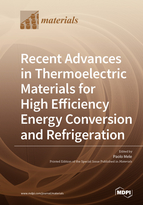Recent Advances in Thermoelectric Materials for High Efficiency Energy Conversion and Refrigeration
A special issue of Materials (ISSN 1996-1944). This special issue belongs to the section "Energy Materials".
Deadline for manuscript submissions: closed (20 January 2022) | Viewed by 13996
Special Issue Editor
Interests: thin films; oxides; superconductors; thermoelectrics; energy materials; heat transfer; vortex matter; sustainability
Special Issues, Collections and Topics in MDPI journals
Special Issue Information
Dear Colleagues,
It is my pleasure and honor to invite you to submit your contribution to this Special Issue of Materials entitled “Recent Advances in Thermoelectric Materials for High Efficiency Energy Conversion and Refrigeration".
Thermoelectricity is a well-known phenomenon enabling the conversion of heat into electric energy without moving parts. Its exploitation has been widely considered to contribute to the increasing need for energy along with the concerns about the environmental impact of traditional fossil energy sources. In the last few years, significant improvements in the performance of thermoelectric materials have been achieved through chemical doping, solid solution formation, and nanoengineering approaches. Furthermore, the feasibility of flexible, stretchable, and conformable thermoelectric harvesters has been demonstrated and has attracted the interest of a wide audience. However, the path for practical applications of thermoelectrics still appears long.
This Special Issue of Materials is intended as an effort to bridge the gap between materials science and applications of thermoelectric materials. Many topics are welcome: New thermoelectric compounds; correlation between material structure and thermoelectric properties; bulk thermoelectric ceramics, oxides, and chalcogenides; bulk thermoelectric alloys and intermetallics; organic and polymeric thermoelectrics; thermoelectric thin films, multilayers, and nanocomposites; theory and modeling; thermal transport and thermal conductivity; applications and devices based on thermoelectric materials; standardization and metrology; and more.
Prof. Dr. Paolo Mele
Guest Editor
Manuscript Submission Information
Manuscripts should be submitted online at www.mdpi.com by registering and logging in to this website. Once you are registered, click here to go to the submission form. Manuscripts can be submitted until the deadline. All submissions that pass pre-check are peer-reviewed. Accepted papers will be published continuously in the journal (as soon as accepted) and will be listed together on the special issue website. Research articles, review articles as well as short communications are invited. For planned papers, a title and short abstract (about 100 words) can be sent to the Editorial Office for announcement on this website.
Submitted manuscripts should not have been published previously, nor be under consideration for publication elsewhere (except conference proceedings papers). All manuscripts are thoroughly refereed through a single-blind peer-review process. A guide for authors and other relevant information for submission of manuscripts is available on the Instructions for Authors page. Materials is an international peer-reviewed open access semimonthly journal published by MDPI.
Please visit the Instructions for Authors page before submitting a manuscript. The Article Processing Charge (APC) for publication in this open access journal is 2600 CHF (Swiss Francs). Submitted papers should be well formatted and use good English. Authors may use MDPI's English editing service prior to publication or during author revisions.
Keywords
- thermoelectric materials
- heat harvesting
- refrigeration







